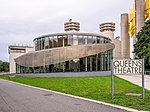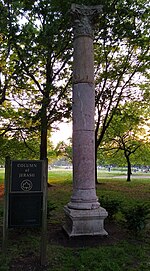Unisphere

The Unisphere is a spherical stainless steel representation of the Earth in Flushing Meadows–Corona Park in the New York City borough of Queens. The globe was designed by Gilmore D. Clarke as part of his plan for the 1964 New York World's Fair. Commissioned to celebrate the beginning of the space age, the Unisphere was conceived and constructed as the theme symbol of the World's Fair. The theme of the World's Fair was "Peace Through Understanding", and the Unisphere represented the theme of global interdependence, being dedicated to "Man's Achievements on a Shrinking Globe in an Expanding Universe". The Unisphere measures 140 feet (43 m) high and 120 feet (37 m) in diameter. It sits atop a 20-foot-tall (6.1 m) tripod base with over 500 steel pieces representing the continents, as well as three steel rings representing the first artificial satellites orbiting Earth. Around the Unisphere is a reflecting pool measuring 310 feet (94 m) in diameter. The base is surrounded by 48 pairs of fountainheads, which were intended to conceal the tripod supporting the globe. Clarke devised plans for the Unisphere while aboard an airplane in 1960. New York City parks commissioner Robert Moses, who had already rejected two plans for iconic structures at the 1964 Fair, approved Clarke's proposal in early 1961. After further refinements, the Unisphere was constructed by American Bridge Company, a division of U.S. Steel, from March to August 1963. Over 51 million people visited the Unisphere during the World's Fair, after which it became a permanent attraction of Flushing Meadows–Corona Park. In the 1970s, the Unisphere was not maintained and became visibly dirty; it was restored in the early 1990s. The Unisphere was made a New York City designated landmark in 1995 and, after another period of disrepair, it was restored in the early 2010s.
Excerpt from the Wikipedia article Unisphere (License: CC BY-SA 3.0, Authors, Images).Unisphere
Unisphere Promenade, New York Queens
Geographical coordinates (GPS) Address External links Nearby Places Show on map
Geographical coordinates (GPS)
| Latitude | Longitude |
|---|---|
| N 40.746388888889 ° | E -73.845 ° |
Address
Unisphere
Unisphere Promenade
11368 New York, Queens
New York, United States
Open on Google Maps









